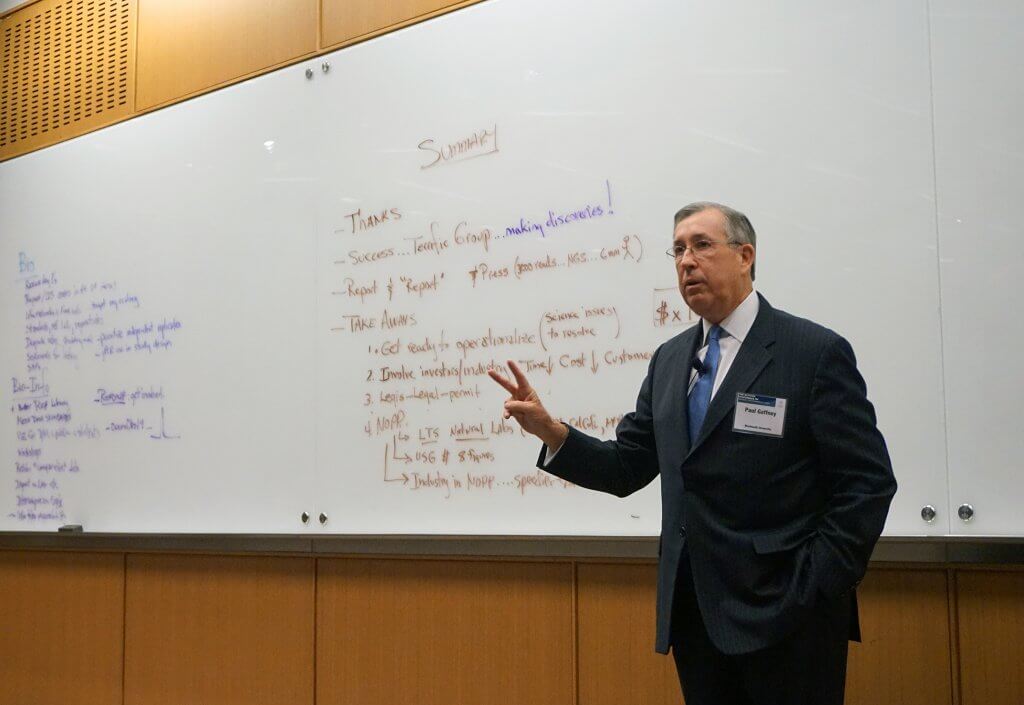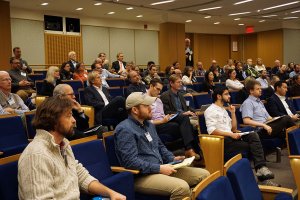 Monmouth University staff and students gathered with 100 of the nation’s leading practitioners of environmental DNA (eDNA) science on Nov. 29 and 30 to share discoveries, state-of-the-art technologies and new methods for this groundbreaking marine life detection method.
Monmouth University staff and students gathered with 100 of the nation’s leading practitioners of environmental DNA (eDNA) science on Nov. 29 and 30 to share discoveries, state-of-the-art technologies and new methods for this groundbreaking marine life detection method.
The National Conference on Marine Environmental DNA was the third in a series of four conferences (The Marine Science & Policy Series) being organized jointly by the Urban Coast Institute (UCI) and The Rockefeller University Program for the Human Environment (PHE). The events are held annually on rotating campuses, with the 2016 National Ocean Exploration Forum at Rockefeller University in New York City, the 2017 Mid-Atlantic Blue Ocean Economy symposium at Monmouth University, and the latest event back in Manhattan. The conference was capped by a luncheon honoring National Academy of Sciences President Marcia McNutt with the UCI’s Champion of the Ocean Award.
Sampling for eDNA is an approach that allows scientists to confirm the presence of fish and other organisms by testing for trace amounts of genetic material that they shed into the water. The technique holds the promise of being less expensive, more humane and more revealing than other longstanding scientific methods that rely on physically catching or observing animals. Monmouth has piloted research in local waters such as Wreck Pond, Sandy Hook Bay, Deal Lake and the Navesink and Shrewsbury rivers.
 The conference highlighted insights provided by eDNA to date and its potential to further scientific knowledge and inform ocean management. One of the innovations discussed was “Go Fish,” an eDNA testing tool developed by PHE Senior Research Associate Mark Stoeckle that can confirm the presence of a given species inexpensively and within a few days. He noted that rapid access to eDNA data could be used to aid authorities with time-sensitive decisions.
The conference highlighted insights provided by eDNA to date and its potential to further scientific knowledge and inform ocean management. One of the innovations discussed was “Go Fish,” an eDNA testing tool developed by PHE Senior Research Associate Mark Stoeckle that can confirm the presence of a given species inexpensively and within a few days. He noted that rapid access to eDNA data could be used to aid authorities with time-sensitive decisions.
One such example was provided by McNutt, who described how eDNA is being used to monitor the threat of invasive Asian carp entering the Great Lakes. Researchers are employing eDNA tests as an early warning system to detect whether the fish have made it past barriers set up in the lakes’ tributaries to thwart their advance.
A goal of the conference was to initiate a commitment by leading scientists and stakeholders to take up eDNA as a cooperative national or regional research theme.
“eDNA opens the door to cheap, frequent, widespread, potentially automated monitoring of the diversity, distribution, and abundance of aquatic life,” said Monmouth University President Emeritus and UCI Ocean Policy Fellow Paul G. Gaffney II. “Government agencies need to take notice.”
UCI Director Tony MacDonald credited PHE Director Jesse Ausubel for his vision in recognizing eDNA’s potential to solve problems and raising its profile throughout the scientific community.
“There is nothing more important than a big idea, and I think this eDNA conference is another example of how a big idea can inspire everybody in the work you do,” MacDonald told the gathering. “Everything you do in science, no matter how detailed, is rooted in a big idea.”
Additional Links
National Conference on Marine Environmental DNA website
Read coverage from National Geographic
Conference program (PDF)

